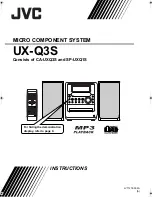
42
ULTRA MUTE
™
AUTOMATION
Almost every signal path in the SR40•8 and
SR56•8 has an electronically-controlled
MUTE
switch, including all channels,
MAIN AUX
RETURNS (A1-A4)
,
SUBS 1-8
,
AUX SEND
MASTERS
, and
MATRIX A-D
. Thanks to the
on-board microprocessor-based
ULTRA MUTE
system, these
MUTE
switches can be activated
in four different ways:
• By pressing a signal path’s local
MUTE
switch.
• By assigning signal paths to one or more
Mute Groups. There are 9 Sets of 10 Groups.
Any combination of Groups (up to ten)
within a Set can be in effect at any one
time. Mute Groups allow you to mute
related signals (e.g., horns, background
vocals, drums) with the push of a button,
and are useful in live sound when you need
to mute groups of channels “on the fly.”
• By assigning signal paths to a Mute Snapshot.
Snapshots differ from Mute Groups in that
they take a “picture” of all
MUTE
switch
settings at a given moment. Recalling a
Snapshot causes all
MUTE
switch settings
to revert to the setting they were in when
the Snapshot was taken. Consequently, only
one Snapshot may be in effect at a time.
Snapshots are typically used in theatrical
applications, where mute settings do not
change within one cue, but do change from
event to event, or scene to scene.
• Via the
MIDI
or
DATA
jacks, any
sequencer can be used to control complex
muting cues. A sequencer is a computer
program that is used to create and edit MIDI
files. On playback, the sequencer does all
the work. All mute nodes (except
AUX
RETURNS B1-B4
,
TAPE RETURNS A
and
B
,
and
MONITOR
) are accessible via
MIDI
or
DATA
using a Note On Channel Message for
each signal path, where the note number
corresponds to a mute node. Snapshots can
be changed using Program Change Messages.
Typical Applications
From the board point of view:
Group Mode
works best to mute groups of
instruments or voices. For example, within one
Set you might assign all the drum mics to one
Group, all the horns to another Group, back-
ground vocals to a third Group, keyboards to a
fourth, and other electric instruments to a fifth
(Group, that is!).
In a show with several different bands per-
forming, you can assign Set 1 to the first band,
with 10 different Groups available for them,
Set 2 to the second band, with 10 different
Groups available for them, etc.
Snapshot Mode
works best with theater or
choreographed acts where timing is essential,
and the show is repeated in exactly the same
manner. You can create a sequence of Snap-
shots that mute the unused microphones
during each act or scene, and simply incre-
ment the Snapshot in
ULTRA MUTE
at each
scene change. You can even automate this with
a sequencer via the
MIDI
or
DATA
ports using
Program Change messages.
From a MIDI point of view:
Use Note On Channel Messages to turn on
and off mute nodes for individual channels. In
addition, you can record mute sequences from
the board into a sequencer, which can later be
played back along with a band.
Note Messages can also turn on and off
Groups 0 – 9 within each Set. You might use a
remote MIDI controller to turn Groups on and
off from a remote location.
Note:
Set numbers can’t be changed via
MIDI, only the Group numbers within each Set.
Use Program Change Messages to change
Snapshots.
4
3
8
7
SUB
5
SUB
6
SUB
7
SUB
8
TALK BACK MIC
PHANTOM POWERED
INTERCOM
INSERT RETURN
MIC 25
LINE IN
DATA
MIDI IN
MIDI OUT
(MACKIE 400-WATT POWER SUPPLY !)
DC POWER IN
SEND
RETURN
SEND
RETURN
SEND
SEND
















































